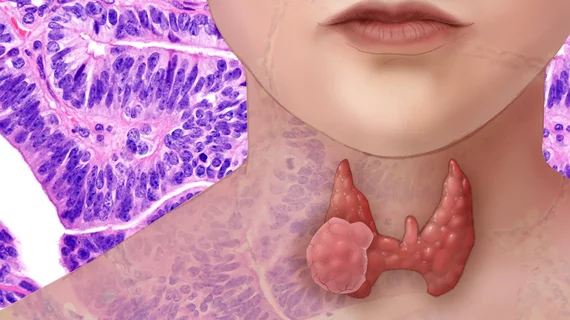Artificial intelligence pinpoints chest CT reports with incidental thyroid nodules requiring follow-up
Artificial intelligence can help to identify chest CT reports that contain incidental thyroid nodules, according to a new analysis in Academic Radiology. However, extra work is needed to get physicians to follow up with ultrasound imaging and close the care loop.
Such unexpected thyroid findings are common in exams of the chest and neck. To help providers address this issue, the American College of Radiology released guidelines on standardizing management of incidental thyroid nodules, but adherence is mostly unknown, experts noted.
Wanting to explore this issue, Duke University developed a natural language processing tool to pinpoint incidental nodules that required sonographic follow-up, and whether docs stuck to the aforementioned recommendations. Bottom line: The AI system found such reports with almost perfect accuracy, but providers did not always stick to the guidelines in these cases.
“Our assessment of recommendation adherence and outcomes in patients with an [incidental thyroid nodule] necessitating follow-up showed limited referrer adherence to appropriate radiologist recommendations, placing patients at risk of delayed diagnosis and radiologists at risk of malpractice lawsuits,” Ryan Short, MD, a former Duke fellow who is now with the Mallinckrodt Institute of Radiology in St. Louis, and colleagues wrote March 20.
For the study, Duke radiologists retrospectively evaluated 21,583 noncontrast chest CT reports logged between 2017 and 2018. They designed an algorithm called FastText with 2018 data to find reports that included a recommendation for thyroid ultrasound or described nodules either greater than 1.5 centimeters or “suspicious.” The research team then used 2017 reports to test-drive the natural language-processing system.
FasText identified reports with incidental nodules meeting criteria for ultrasound follow-up with 96.5% accuracy and 92.1% sensitivity, Short et al. found. Out of more than 10,000 chest scans from 2017, sonographic follow-up was indicated according to the ACR’s guidelines in 81 patients or 0.8%. Physicians explicitly recommended such imaging in nearly 47% of cases (38/81) and obtained this information in less than half of patients in which it was appropriately recommended (17/35).
You can read more about the study in the Association of University Radiologists’ official journal here.

